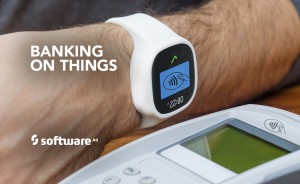Banking on (the Internet of ) Things
Blog: Software AG Blog - Reality Check
 As Bart Schouw pointed out in his April 15th blog, banks may have been among the first to adopt the Internet of Things (IoT) when they installed ATMs in the 1970s. But they have fallen behind other industries in deploying the IoT since then.
As Bart Schouw pointed out in his April 15th blog, banks may have been among the first to adopt the Internet of Things (IoT) when they installed ATMs in the 1970s. But they have fallen behind other industries in deploying the IoT since then.
While the insurance industry is using IoT to create opportunities for new business models—with telematics insurance, wellness programs and smart home devices, both to improve underwriting disciplines as well as reduce the risk of losses—banking IoT has been lurking around as an existing model optimizer rather than a new business model enabler. For example, banks have been adopting IoT internally for efficiency improvement with Smart Offices.
Some retail banks are also eyeing IoT technology, such as geo-location, geo-fencing and beacon technologies to improve marketing and sales effectiveness. They can use IoT to recognize a customer in a shopping mall and send promotional messages that would make customer spend more with their credit card, for example.
They can also use it to recognize a customer who is near a branch to invite him in to talk about a new loan offer. Or maybe to discuss a new investment product that they know he’s been looking at on their clickstream-enabled website. All of these cases aim to improve the use of existing spaces or to sharpen sales and marketing effectiveness and, with that, improve employee and customer experience. But they are not really transformational in the way the customer relationship is managed or new revenue streams are created.
With regards to the customer relationship, it may be a trust issue. In Accenture’s 2015 Vision for Banking paper, the consultancy said that banks have a long way to go to gain the customer trust needed to make the most of personal data for deep personalization.
“While banks already have massive amounts of customer data, more data will be needed to tailor experiences. At the same time, customers have very limited understanding as to how banks use their data. A focus on customer trust will be as important as customer experience in the future.”
For new revenue streams, we might see progress in payments where a more transformational adoption of IoT means that manufacturers will build payments capabilities into Things, so the devices allow you to pay more easily or eventually make payments by themselves.
Trade finance is an area that would strongly benefits from connecting physical goods movement with associated payments, and a hot topic when it comes to IoT-driven business transformation.
At Sibos last year, Oliver Bussman, CIO at UBS, said: “Trade finance is ripe for reinvention. It is very complicated, very time- and paper-intensive. When the movement of physical goods can be linked it can be simplified massively going forwards. It is an area ready to be disrupted.”
There are a number of opportunities to leverage IoT in banking. It is now time for banks to get on with Things.
The post Banking on (the Internet of ) Things appeared first on Reality Check.
Leave a Comment
You must be logged in to post a comment.







